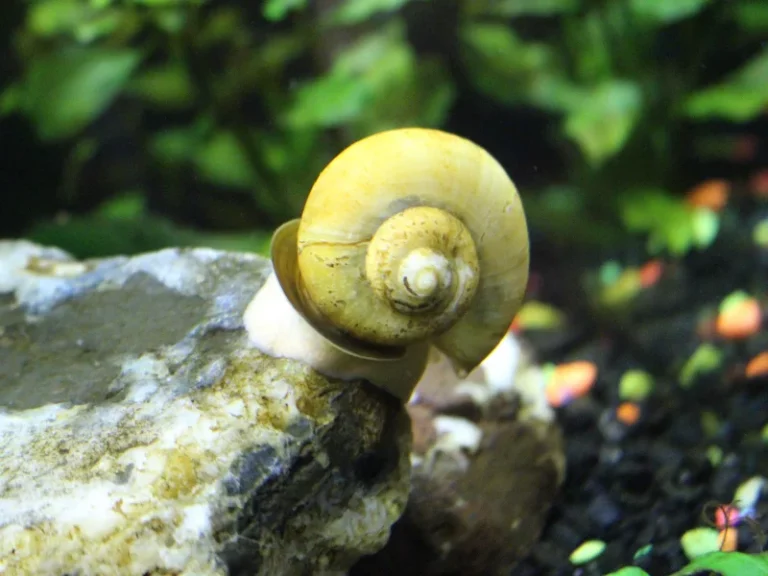There are several ways to tell the gender of a snail. However, you must remove the snail from the aquarium and observe it. If you hold the snail upside down for about 10 minutes, it will get out of the shell to right itself. As the snail comes out of the shell, you will distinguish the male from the female by a penis sheath located at the lower part of the mantle.
The main difference between a male and a female snail is that the male has a penis sheath but the female doesn’t. For female snails, the copulation organ is located on the right side of the snail, lateral to the penis. Male and female snails also differ in the snail shell structure and color.
Although you can see the penis sheath with the naked eye, use a magnifying glass to distinguish the gender in smaller snails like the bladder snails. This article will teach you all the differences. You will also learn about snails that change their sex and why they do so. However, whether they change their sex or not, you can still differentiate between male and female snails.

Main differences between male and female snails
Here are the main differences between male and female snails:
Physical traits
Looking at the physical traits is the easiest place to start if you want to identify a male or a female snail. There are two main physical traits:
- The reproductive organs
- The protruding edge of the snail shell
The snail’s reproductive organs
The male and female reproductive organs are much easier to see in snails. However, you need a magnifying lens to see clearly, especially in smaller snails.
Remove the snail from the aquarium and hold it upside down for about 10 minutes. The snail should naturally feel uneasy and start coming out of the shell.
However, keeping the snail in that position for long periods can stress it. Therefore, if the snail stays in the shell longer, return it to the aquarium and try again later.
As the snail pushes its operculum to remove its head, you will see an opening under its head. You will see two holes in females and only one in males.
The left hole in both snails contains their gills. But in males, the place of the other hole is replaced by a penis sheath.
Distinguishing snail gender using physical traits such as the reproductive organs is difficult. But with time, you will get better at it.
As you do so, be careful since snails outside their shells are vulnerable to predators like kuhli loaches which eat small snails.
The protruding edge of the shell
Another physical trait for telling the difference between male and female snails is a protruding edge along the base of the shell.
Checking the reproductive organs of a snail requires the snail to get out of the shell. But you can look at the protruding edge along the base of the shell even when the snail has retreated.
Put your snails on a flat surface and look at the base of the shell, along the circumference of the operculum.
In male snails, the shell’s edge is protruding. In other words, the calcium carbonate that forms the shell is heavily deposited at the base. However, female snails don’t have a protruding edge. Female snail shells grow uniformly throughout their lives.
If you are buying a snail, it is much easier to identify their gender by looking at their reproductive organs or the shell structure. However, there are some methods you can use at home to tell the difference between your male and female snails.
Let’s look at them below.
Tip: The male and female snail reproductive organs are located close to their head and not the tail region.
Shell color
The shell color effectively tells the difference between male and female snails at home because it only occurs during mating season. Do not use shell color as a way to tell the difference when you are purchasing the snail.
Most importantly, the change in shell color occurs only in female snails. On the other hand, the male snail’s shell color will remain the same throughout the year.
Expert snail keepers agree that when female snails are about to give birth, their shells turn from their usual dark to very light colors. The shell colors don’t just get intense, but it also appears glossy.
It is particularly essential for separating pregnant female snails from the rest of the herd. If you don’t know the male and female snails in your tank, you can wait for their mating season to tell the difference and sort them by shell color.
Behavior
Like the physical traits, snail behavior is another easy way to distinguish the male from the female. However, you cannot use snail behavior at the pet store to pick a female or a male snail. That is because, like shell color, snail sexual behavior happens at specific times.
During the mating season, female snails emit air- and waterborne pheromones to attract male snails. Male snails instinctively mount the females during copulation. If you have snails in your aquarium, look at the ones that like to climb on top of other snails.
When a male arrives, it will climb on top of the female and position itself on the right side of the female’s shoulder. That is near the female’s sexual organ. You will also know the snail is a male if it takes between one and 12 hours at the back of the other snail.
In short, the snail that has never climbed on top of the other in your tank is most probably a female. On the contrary, the snail which mounts its tank mates frequently is most likely a male.
In general, male snails tend to be more aggressive than their female counterparts. In calm breeds like mystery snails which are compatible with betta fish and other aquatic animals, the males might still show aggression where the females are calm.
Here is a summary of the differences between male and female snails
| Male snails | Female snails |
| Have a penis sheath. | Have no penis sheath. |
| The shell’s edge is protruding. | The edge of the shell is uniform. |
| No significant change in shell color. | Their shell turns glossy during the mating season. |
| Males climb on top of females to mate. | Female snails do not climb male snails. |
Do snails change their sex?
Snails such as Apple snails are hermaphrodites, meaning they have both the male and female reproductive organs. However, for fertilization to occur, they need one another.
Some snails are dioecious. That is, they are either males or females. Although mating can happen anytime, snails usually lay eggs at night.
They lay about 80 eggs at night in a damp underground nest. Regardless of their sexual orientation at birth, nearly all snails undergo gender transformation at some point in their lives. A good example is the slipper limpet snail. The snail is hatched as a male but becomes a female in adulthood.
Some studies also show that as long as male slipper limpet snails can touch one another, they will become females sooner. However, the bigger snail will turn into a female much faster than the smaller snail.
Behavioral, chemical, and visual factors can also trigger a sex change in snails. Other species like the mystery snails also found their name from their mysterious sexual orientation. Although mystery snails are not hermaphrodites, they can change their gender from male to female or vice versa.
Whether they change their sex or not, you can still differentiate between male and female snails. Look at the physical traits such as the penis sheath and the protruding edge of the shell.
According to behavior, the snail which mounts its tankmates frequently is most likely a male. The snail that has never climbed on top of the other in your tank is a male.
However, remember that the male and female snail reproductive organs are located close to their head, not in the tail region.
Conclusion
Telling female and male snails apart is not easy especially to the untrained eye. However, with practice and the differences above, you can tell most snail species apart in terms of their gender. From their shells to their behavior, size and even sexual organs, telling mystery snail genders apart isnt hard.
References
Smithsonian Tropical Research Institute. (2015). The power of touch: Sex-changing snails switch sooner when together. Science News.
University of California. How Do Snails Reproduce?
Florida Museum. Freshwater Snails of Florida ID Guide.

